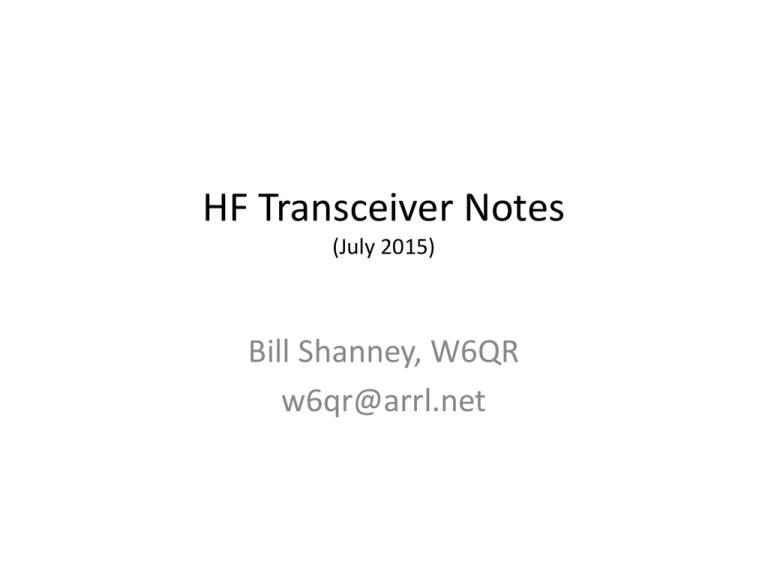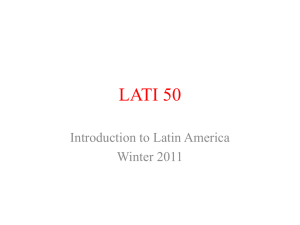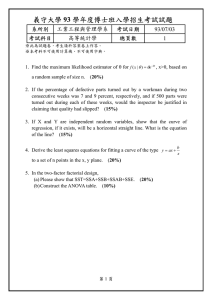HF Transceiver Notes
advertisement

HF Transceiver Notes (July 2015) Bill Shanney, W6QR w6qr@arrl.net HF Station Considerations • If you ask a contester what the most important part of their station is they will tell you it is the antenna – I agree with that and there are many excellent books written about antennas – I’m not a contester but I pay attention to their equipment choices since they have the most demanding requirements • The next most important thing is operator skill • Then comes the transceiver – No books on the subject – Misleading manufacturer claims • Don’t feel inadequate if you don’t understand transceiver performance numbers, it is a very complex subject. What Transceiver Should I Buy? • What are your goals and interests? – – – – – – DXing Rag Chewing Home brewing Contesting QRP (<5W) Each of these lead to different equipment and/or antenna decisions • What modes do you want to work? (CW, SSB, Digital) • What is your budget? • How much space do you have for your shack? What’s Important • A basic level of performance – Receiver Dynamic Range – Clean transmitter • Ergonomics – If it is not easy for you to use you won’t use it – Often overlooked by new hams • Features that match your operating interests/needs – – – – – IF filters to cut interference Noise reduction that works for your location Audio equalizers (Rx and Tx) Built in antenna tuner Others Mistakes Hams Make • Buying a transceiver based only on manufacturers claims • Buying a transceiver because your friend has that model • Buying more transceiver than you need or can handle can lead to frustration • Not considering ergonomics • Not sitting in front of candidate rigs at a store or hamfest to get the feel of it • Assuming a built in ATU can tune any antenna Transceivers • A transceiver is the most expensive piece of equipment in a basic station – You can have a great antenna, but if your transceiver is poor you won’t be able to work as many stations – I rely on test data to make my decisions • QST product reviews are excellent • Sherwood Engineering data is also excellent http://www.sherweng.com/table.html • eHam.net reviews are subjective • Ergonomics are very important. If operation does not feel right it won’t be much fun. – I like single function knobs, many radios have multi function knobs and buttons – Control layout must make sense to you…not to your friend • Most high end radios are very complex to operate. If you don’t operate often you may/will forget how to use them; this always happens when you are trying to work some rare DX. – Not suitable for beginners who do not have a good understanding of how they work – Buy a simpler radio for a 1st rig. It can be your back-up when you decide to get a better rig Ergonomics Receiver Dynamic Range • Blocking dynamic range measures the receivers ability to operate in the presence of a strong signal without saturating. Saturation causes small signal suppression and may make copy more difficult. • Third order or two tone dynamic range measures the amount of potential self interference generated by multiple close spaced signals in its pass band. These signals mix and produce low level signals that can interfere with the signal you are trying to copy • Both of these are important when operating on a crowded band with big signals present • Don’t be fooled by the Sherwood data, he simply ranks by Third order dynamic range. He always says it is an arbitrary choice in his talks. Personally I find Blocking dynamic range equally important…you know it when a big gun decides to tune up close to your frequency • For CW you care about 2kHz spacing DR (80-90dB DR3) • For SSB you care about 5kHz spacing DR (70-80dB DR3) Receiver Dynamic Range Limitations Big Interferer causes front end compression Signal Signal Suppression Blocking Dynamic Range Two tones mix and cause interfering signals Signal Interference Third Order Dynamic Range Transceivers – cont’d • Performance parameters I use for comparisons (CW) – – – – – Third order dynamic range Blocking dynamic range Roofing filter bandwidth Keyed transmit bandwidth Composite phase noise • Roofing filter bandwidth – For serious CW operation you want 500Hz, 3kHz radios pass too much noise on to the A/D converter. The A/D can saturate on static crashes. – For SSB 3kHz is just fine. Contesters like 2.1 or 1.8kHz. • Sherwood vs. ARRL data – Some parameters are measured differently so don’t compare the two • Reciprocal Mixing Dynamic Range – This used to be called phase noise limited DR3 – This is a DR3 limiter in many modern rigs. Recent ARRL reports publish RMDR and DR3 separately. Sherwood uses the worst case for DR3. Transceivers – cont’d • Receiver performance is important – CW DXer’s and contester’s need 80 dB of close in dynamic range (2KHz spacing 3rd order IM, DR3) to be able to separate and copy signals on a crowded band of high power stations. In an area with lots of hams like L.A. 90 dB is better. – Casual and SSB operators can opt for less dynamic range – Low band operators need less dynamic range as well because the noise floor is higher • 40M noise is 15dB higher than 15M noise – Good IF filtering is also important to reject interference • 500 Hz BW for CW • 2.3 KHz BW for SSB – If you are serious about DXing dual receive capability is a big plus (2 receivers or dual-watch) Atmospheric Noise From: CCIR Report 322 Receiver performance with big signals in band – CW centric Assuming a typical radio; Noise Floor= -128 dBm (~S=0); Preamp OFF; 500 Hz CW filter 2 kHz Spacing Dynamic Range Signal Level Causing 3rd Order IMD = Noise Floor 55 dB 60 65 70 S9 S9+5 dB S9+10 dB S9+15 dB FT-757 FT-101E KWM-380 TS-830 75 S9+20 dB IC-756 Pro II/III IC-7600 FT-950 80 S9+25 dB Ten-Tec Omni VII IC-7800 IC-765 FTdx3000 85 S9+30 dB R9500 TS-590S TS990 FTdx9000 90 S9+35 dB Ten-Tec Orion I Ten-Tec Eagle 95 S9+40 dB Ten-Tec Orion II Flex 6300 100 dB S9+45 dB Elecraft K3, KX3 Radios in This Class Ref: Roofing Filters, Transmitted BW and Receiver Performanceby Rob Sherwood, NC0B FT-2000 FT-1000D IC-7851, FTdx5000 FTdx1200 FLEX 6500 CW vs. SSB • • • • • • • The 5KHz spacing third order dynamic range is more appropriate for SSB operation. Most SSB stations occupy more than the minimum 2.5KHz bandwidth. This is especially true during contests and DXing when everyone will be using their speech processor Most transceivers have better dynamic range at the wider spacings (see the QST reviews). The noise bandwidth of a SSB signal is roughly 8dB wider than CW (500Hz typical BW) Typical average power in SSB is only 10-20% of PEP power. Lets say 25% with modest processing (or 6dB). That means CW has a 14dB advantage in terms of signal-to-noise ratio (SNR) vs. SSB. Another way to look at it is you need 25 times as much power on SSB to get an equivalent SNR at the receive end of a contact. For the same output power an SSB signal has 14dB less SNR than a CW signal so you need 14dB less dynamic range While 90dB is useful for CW, 76dB is all you need for SSB (assuming you are not a big guns contester on the East coast with a 5 element mono band Yagi facing Europe in a big contest) Transmitters • A clean transmit signal is very desirable – Reduces interference to adjacent stations – CW stations should have a narrow Keyed bandwidth; do not use a fast rise time – SSB stations should have low Transmit Intermodulation Distortion; limit the use of the speech compressor. Bob Heil feels an equalizer is more effective (2015 Dayton Contest University You Tube). FLEX 6000 SDRs use a better method to reduce compression distortion. • Transmitter power is an interesting topic – 100 watts is plenty of power for normal operation – Many hams want to be the 1st to work a new country and run 1500 watts; 100 watts plus operating skill will beat them most of the time – Others like the challenge of QRP and run <5 watts. Low power levels like this can be very frustrating for beginners – I generally run 400W on the lower bands to stay above the noise • For a beginner on the HF bands 100 watts is a good starting point. – 1500 watts will almost certainly cause RFI in your home and possibly your neighbor’s too SDR Transceivers • I’ve left some comments on computer controlled Software Defined Radios (SDR) until the end of the transceiver topic because I didn’t recommend them for a primary rig until recently – They require a fast computer with a very fast interface to work properly. You also need to understand software – I like to turn knobs, using a mouse for everything gets tiring • They do have some good points: – – – – • • The dynamic range performance is excellent Easily configured for digital modes Very good for SSB operation The spectrum scope is very versatile The FLEX 6000 Series SDR fixed everything I did not like about SDRs except the need for a computer. If you prefer computer interfaces I recommend considering this new rig. The FLEX 6300 may not be a good choice since it does not have any front end filtering and its performance is not as good as the 6500/6700 models – 2015 Field day reports show the lack of filters is a problem • FLEX recently announced a Maestro control panel for their 6000 series radios which makes operation more like a conventional rig – Limited number of knobs and buttons What Brand Should I Buy?? • I’m not tied to any one brand, they all have plusses and minuses. I have at least one transceiver from each of the major manufacturers in my inventory – Elecraft K3 for most operation, KX3 for portable operation. Highest overall performance available today, ergonomics took some getting used to. This is a very complex radio. – ICOM 7600 is my back-up rig, very good spectrum scope and overall ergonomics. 3kHz roofing filter limits dynamic range on the whole ICOM line-up. I leave it on 6M SSB for Es. This is a mid-level radio. – Kenwood TS-590s in my bedroom for when the grandkids visit and my shack becomes a spare bedroom. This radio is the biggest bang for your buck in HF today, high performance for a modest price. A great beginners radio. – Ten Tec Orion was the first of the new high dynamic range transceivers. Impressive performance but poor ergonomics. The Orion is a very complex radio. OMNI models are very good and easy to operate. – Yaesu FT-5000MP is my favorite rig to operate but its performance is not as good as the K3 on the noisy low bands and it has a wider than necessary keyed Tx bandwidth (recently improved with a firmware update). This is a very complex radio. Setting Up a Station • Install a good safety ground – Not a water pipe – Not your AC socket ground • A good ground will also help reduce RF Interference • Use a common point ground in the shack to avoid ground loops • Make sure you will have enough AC power, I use a dedicated line • Think about DC power distribution – I use power pole connectors on all dc leads • Use lightning arrestors on your antenna feedlines before they enter the house


